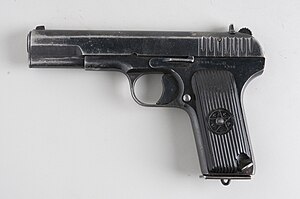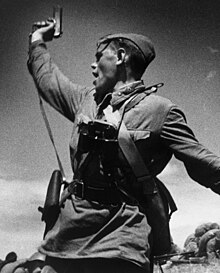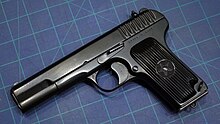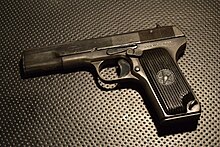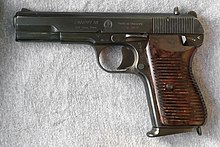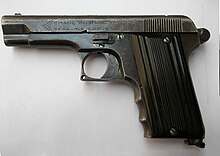The 7.62 mm caliber is a nominal caliber used for a number of different cartridges. Historically, this class of cartridge was commonly known as .30 caliber, the equivalent in Imperial and United States Customary measures. It is most commonly used in hunting cartridges. The measurement equals 0.30 inches or three decimal lines, written .3″ and read as three-line.

The Karabiner 98 kurz, often abbreviated Karabiner 98k, Kar98k or K98k and also sometimes incorrectly referred to as a K98, is a bolt-action rifle chambered for the 7.92×57mm Mauser cartridge. It was adopted on 21 June 1935 as the standard service rifle by the German Wehrmacht. It was one of the final developments in the long line of Mauser military rifles.

Mauser, originally the Königlich Württembergische Gewehrfabrik, was a German arms manufacturer. Their line of bolt-action rifles and semi-automatic pistols was produced beginning in the 1870s for the German armed forces. In the late 19th and early 20th centuries, Mauser designs were also exported and licensed to many countries, which adopted them as military and civilian sporting firearms. The Gewehr 98 in particular was widely adopted and copied, and it is the foundation of many of today's sporting bolt-action rifles.

The Mauser C96 is a semi-automatic pistol that was originally produced by German arms manufacturer Mauser from 1896 to 1937. Unlicensed copies of the gun were also manufactured in Spain and China in the first half of the 20th century.
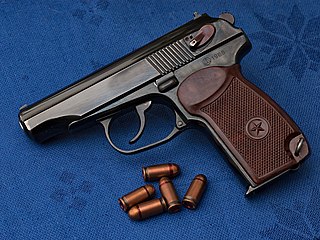
The Makarov pistol or PM is a Soviet semi-automatic pistol. Under the project leadership of Nikolay Fyodorovich Makarov, it became the Soviet Union's standard military and Militsiya side arm in 1951.

The MAT-49 is a submachine gun which was developed by French arms factory Manufacture Nationale d'Armes de Tulle (MAT) for use by the French Army and was first produced in 1949.

The 7.62×25mm Tokarev cartridge is a Soviet rimless bottleneck pistol cartridge widely used in former Soviet states and in China, among other countries. The cartridge has since been replaced in most capacities by the 9×18mm Makarov in Russian service.

The Nagant M1895 is a seven-shot, gas-seal revolver designed and produced by Belgian industrialist Léon Nagant for the Russian Empire.
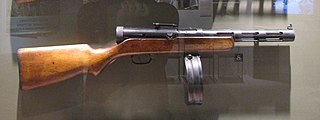
The PPD is a submachine gun originally designed in 1934 by Vasily Degtyaryov. The PPD had a conventional wooden stock, fired from an open bolt, and was capable of selective fire. It was replaced by the PPSh-41.

The PPSh-41 is a selective-fire, open-bolt, blowback submachine gun that fires the 7.62×25mm Tokarev round. It was designed by Georgy Shpagin of the Soviet Union to be a cheaper and simplified alternative to the PPD-40.

The Type 54 and its variants are Chinese copies of the Soviet type Tokarev TT-33.
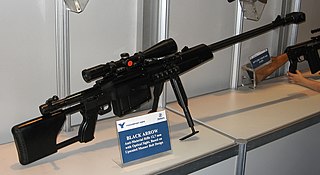
The M93 Black Arrow is a 12.7×108mm anti-materiel rifle developed and manufactured by Zastava Arms.
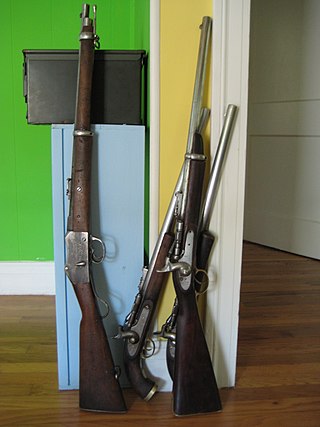
A Khyber Pass copy is a firearm manufactured by cottage gunsmiths in the Khyber Pass region in Pakistan.

The 7.65×25mm Borchardt cartridge was designed by Georg Johann Luger for use in Hugo Borchardt's Borchardt C-93 pistol. It was the first successful rimless pistol cartridge.

The 9×25mm Mauser is a cartridge developed for the Mauser C96 service pistol around 1904 by DWM. Mauser pistols in this relatively powerful caliber were primarily intended for export to Africa, Asia, and South America. The 9mm Mauser Export cartridge was produced specifically for Mauser pistols and carbines made from 1904 to 1914 and then later from approximately 1930 to 1945 for submachine guns chambered for this caliber.
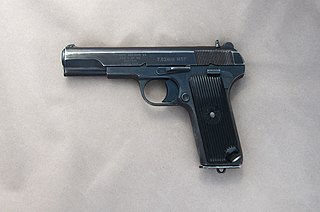
The Zastava M57 is a Yugoslavian and Serbian semi-automatic pistol produced by Zastava Arms. It was the standard service pistol of the Yugoslav People's Army from 1961 until the early 1990s. The M57 was an unlicensed derivative of the Soviet TT pistol, but incorporated a number of detail modifications, namely a longer grip and a slightly larger magazine. Zastava reverse engineered the Soviet TT in 1954, and began serial production of the weapon type as the M57 in 1963.
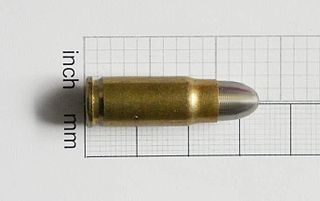
The 7.63×25mm Mauser round is a bottleneck, rimless, centerfire cartridge, originally developed for the Mauser C96 service pistol. This cartridge headspaces on the shoulder of the case. It later served as the basis for the 7.62mm Tokarev cartridge commonly used in Soviet and Eastern Bloc weapons.

The 7.62×39mm round is a rimless bottlenecked intermediate cartridge of Soviet origin. The cartridge is widely used due to the worldwide proliferation of Russian SKS and AK-47 pattern rifles, as well as RPD and RPK light machine guns.

The M49 submachine gun is a Yugoslavian submachine gun chambered in 7.62×25mm Tokarev, designed for use with the Yugoslav People's Army. While externally similar to the PPSh-41, as well as being able to interchange magazines, the M49 is actually very different in both construction and design. More similar in nature to the Italian Beretta Model 38, the M49 features a one-piece tube receiver which contains the bolt, recoil spring and buffer mechanism. Constructed of machined parts as well as simple tubing, the receiver assembly incorporates a ventilated barrel shroud to protect the operator from being burned during periods of rapid-fire, as well as a simple muzzle brake to steady the weapon.
